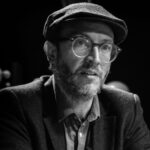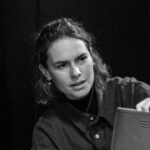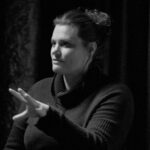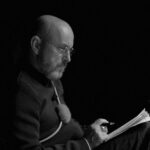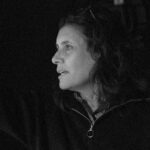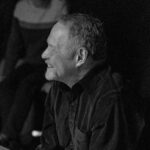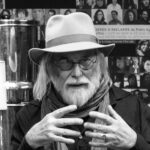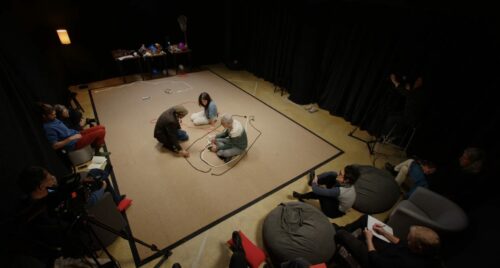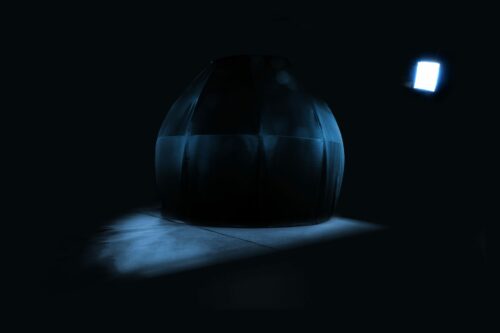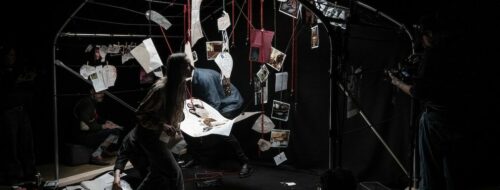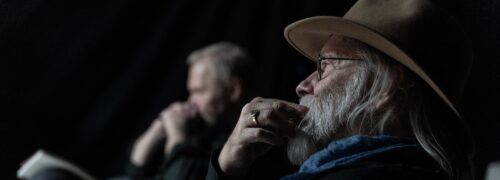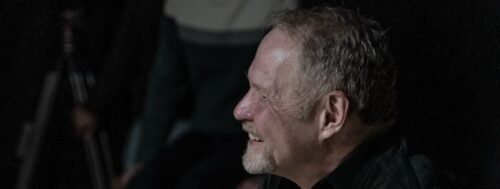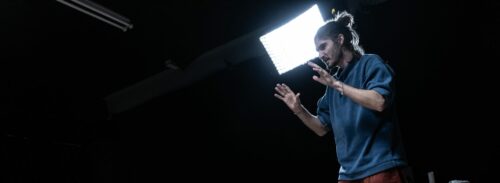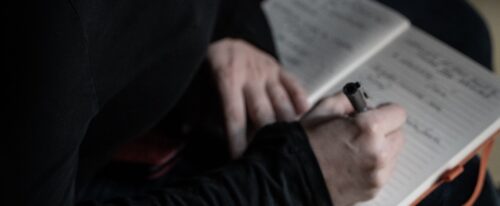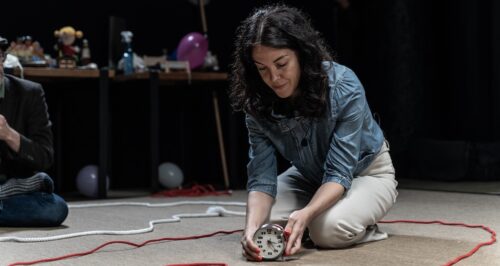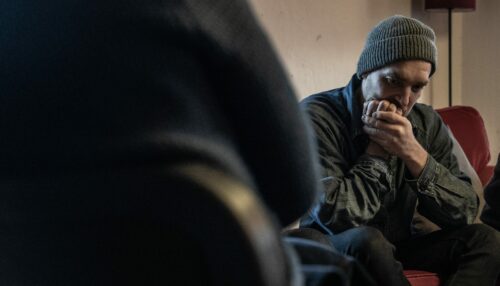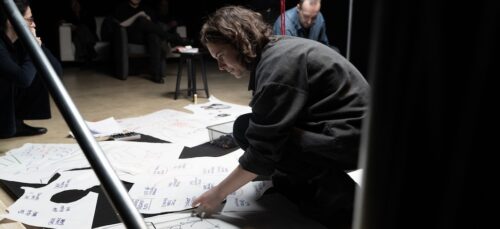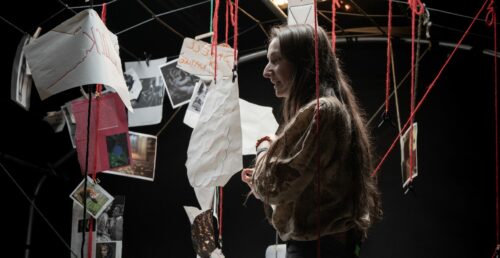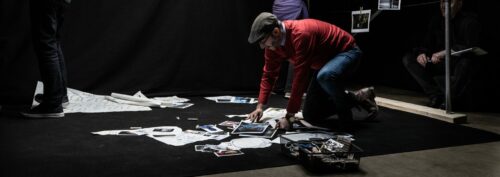1. The Cave
The Cave is a three-dimensional space (a greenhouse-like structure) measuring 5 to 15 m², depicting the settlement of a fictional world within a real space.
It is an analog narrative space populated by objects hung/hanging overhead (drawings, faces, places, sketches, keywords, maps of all kinds, objects, collages, etc.). The author can enter the space, approach, hang, modify, explore, experiment, create connections, causality, meaning, etc. When collaborative development is involved, each author/co-author can have their own workspace within the Cave, their own corner, at their own pace, while echoing a reality of exchange with other co-authors or collaborators.
In the apparent chaos of the Cave, the aim is to stimulate and open up possibilities and combinations that would not be possible or imaginable without this spatialization of ideas. Here, the key components of cognitive exploration involve sight (A) and the body moving through space (B).
— As part of its 5th season, the StoryTANK team wanted to try a new experiment, under the guidance of six passionate and captivating researchers. The goal was to test and film the emergence of story ideas within experimental frameworks created by LA FABRIQUE DES MONDES — a unique initiative in Europe, developed at Le Groupe Ouest since 2023, under the auspices of the French Ministry of Culture.
The experience was offered to six screenwriters or filmmakers from six different European countries. Here, the StoryTANK provides an opportunity to explore and shed light on the creative process.
Below, a debrief by screenwriters and researchers, as they reflect on their experience.
FEELING THE STORY RATHER THAN CONCEPTUALIZING IT
“It’s one thing to conceptualize, to think, to reflect, and it’s another to truly feel on an emotional and rational level.”
When you enter the Cave, you don’t know what you’re going to find there. We don’t go straight in: we have a short period of preparation with different tools that give us the opportunity to try to make this Cave like a small house in which we can develop ideas. The fact of not entering alone, but within a group, allows us to find a balance that shapes a shared logic of development: to place ourselves in a position of multiple curiosities, within a collective brain. There are components that resonate immediately, like obvious facts. What is most surprising is to realize that it is one thing to conceptualize, to think, to reflect, and it is another to really feel all of this in a concrete space, mixing an emotional level and a rational level. The Cave allows this. – Massimiliano Nardulli
THE CAVE AS A PROTECTED SPACE FOR STORY GENERATION
“It’s fundamental to walk in a space that isn’t just visual, but that becomes increasingly immersive.”
In the Cave, I immediately have the feeling that I’m in a protected space, where I can quietly see and imagine things, make mental connections, alone and in a group, without ever thinking about the outside world. We brainstorm ideas and experiments, possibilities to best develop the small seed of the story that has been germinating since the beginning of the experience. It’s a total immersion, which includes others. It’s fundamental to walk in a space that isn’t just visual, but that becomes increasingly immersive. Massimiliano Nardulli
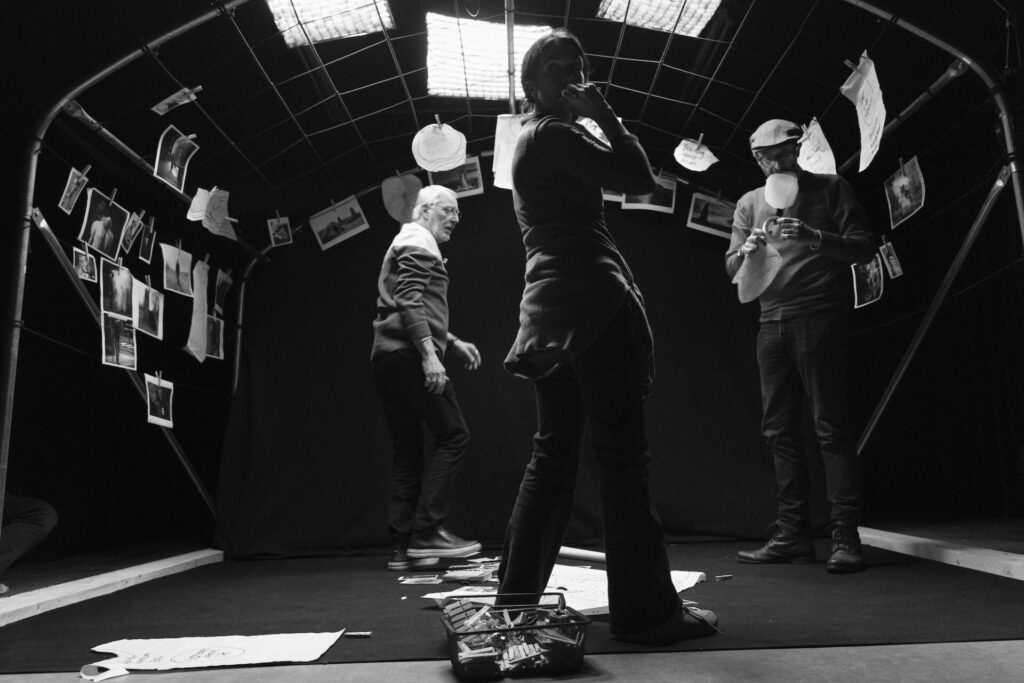
A COMPLETE IMMERSION IN THE NARRATIVE COMPOSITION
“The Cave even transforms the way we think, through our bodies: which is essential in the writing process.”
Starting with a film idea, a small seed in the order of a scene, an image, or a situation, the Cave perfectly fulfills its role as a possible space for complete immersion in that image or situation. We immediately started getting up, bending down, moving around: everything obviously became much more organic and alive. How can we think through our bodies? For me, it’s quite essential in the writing process. Violette Garcia
THE COLLABORATIVE AND SHARED WRITING PROCESS
“In the Cave, we are never blocked or crushed by a wall”
I often suffer from sitting, from being static, or from being faced solely with a wall or a painting. It can be very interesting at certain moments in the development of a film, but it can also be completely overwhelming. When you’re facing a wall, you’re there, motionless, as if something could just fall on you, but you have no solution. In the Cave, you can enter it, leave it, add things, you can wander around. We’re never blocked or crushed by a wall: the development of the story very quickly becomes collaborative and shared. – Violette Garcia
THE MULTITUDE AND PLASTICITY OF IMAGINARIES
“In the Cave, we spatialize the narrative: we bump into it!”
The Cave orchestrates a dynamic of horizontality, which allows us to share things, to listen to each other better, together, on an equal footing. The Cave generates a multitude of imaginaries by spatializing our thoughts, without us feeling that things are fixed, once and for all, or that there is a right or wrong way of doing things, since we can always come back, pick something up there, put it somewhere else. Breathing is located in the bodies, and also in the images and words, the paper, the tools, and everything we handle. A powerful moment in the Cave is when we stand and hang up all the materials initially placed on the ground. We wander, then, between the characters, we start to suspend these things, we then spatialize the story: we bump into it! – Violette Garcia
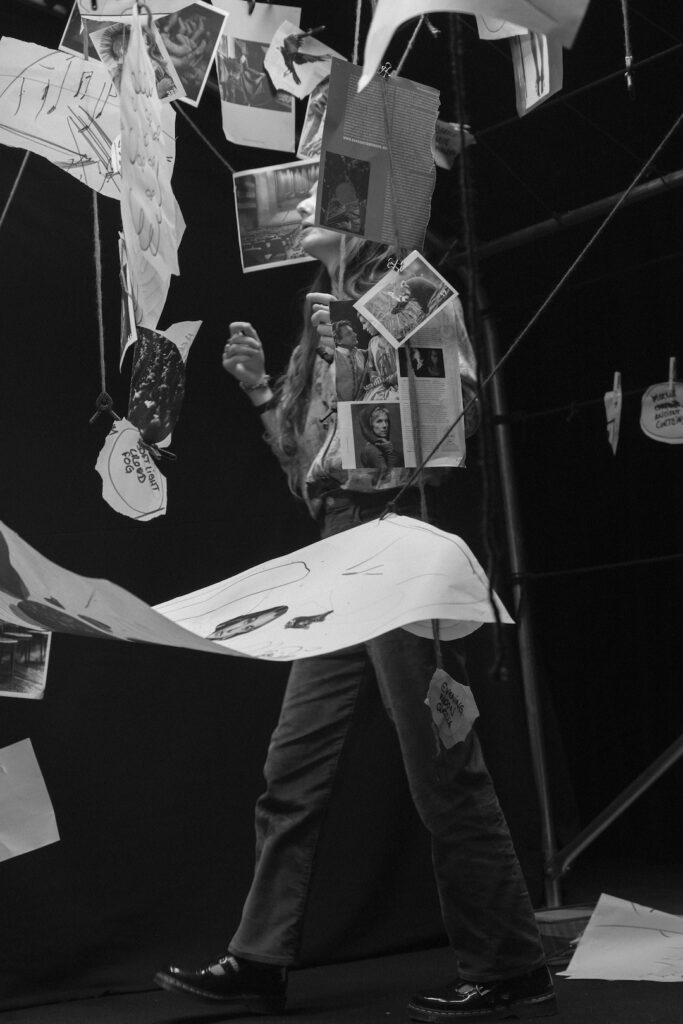
BEING IN THE PRESENT TO COMPOSE THE STORY
“The Cave’s strength is that it’s a place in its own right, a bit like a church, a meditation center: a place where you practice something outside the everyday imagination.”
I like the story being developed to be non-linear. Everything is, in a way, all at once: what’s suspended above, what’s below, what’s on the walls. In the Cave, I feel like I’m outside of time. The Cave’s strength is that it’s a place in its own right, a bit like a church, a meditation center: a place where you practice something outside the everyday imagination. When you sit at a table, you’re not in the present, you’re in the past. Everything has already happened. And in a way, when we write, we try to remember. Here, standing, moving, together: we are in the present. – Raitis Ābele
BUILDING THE STORY, EVEN BEFORE THINKING ABOUT IT
“In the Cave, we are like wasps, shaping a nest”
In the Cave, we are like wasps, shaping a nest. We take materials, put them on the walls, and not only that: we build something. We really have this feeling of building, even before thinking. We can take a photo that recalls something and place it here or there… We immediately create a connection with our co-authors, when we walk and talk at the same time. – Raitis Ābele

FEELING THE NARRATIVE TO MAP IT
“In the Cave, we begin to make sense of chaos”
With the Cave, we’re suddenly offered a small play space, almost a sandbox, with these small elements that we can use to invent stories: photographs generated by AI, from words we’ve generated ourselves, from a seed of an idea, and also magazine images, and it was as if we entered with chaos from multiple directions. And we begin to make sense of this chaos, arranging the collected elements and then, for some reason, ending up hanging them in the center. We manage to map the space. We wonder, then, what’s beneath the scene, who these people are, which opens up possibilities that we don’t have if we simply work around a table or with the help of a wall. We feel everything within this space. – Isla Badenoch
THINKING PHYSICALLY ABOUT THE STORY
“Being able to physically walk around the story rather than seeing it in a linear, flat way helps enormously to move the narrative forward.”
In our story, there are wasps, and we hang them. It’s almost as if we can embody what it would be like to be in the audience of the concert hall where we’ve set the story, surrounded by wasps. This allows us to think about the behavior of the characters in the audience, what their behavior evokes about them: we move from an abstract idea to real characters with personalities and stories. Inside, we don’t pause to go back. Being able to physically walk around the story rather than seeing it in a linear, flat way helped enormously to move the narrative forward. – Isla Badenoch
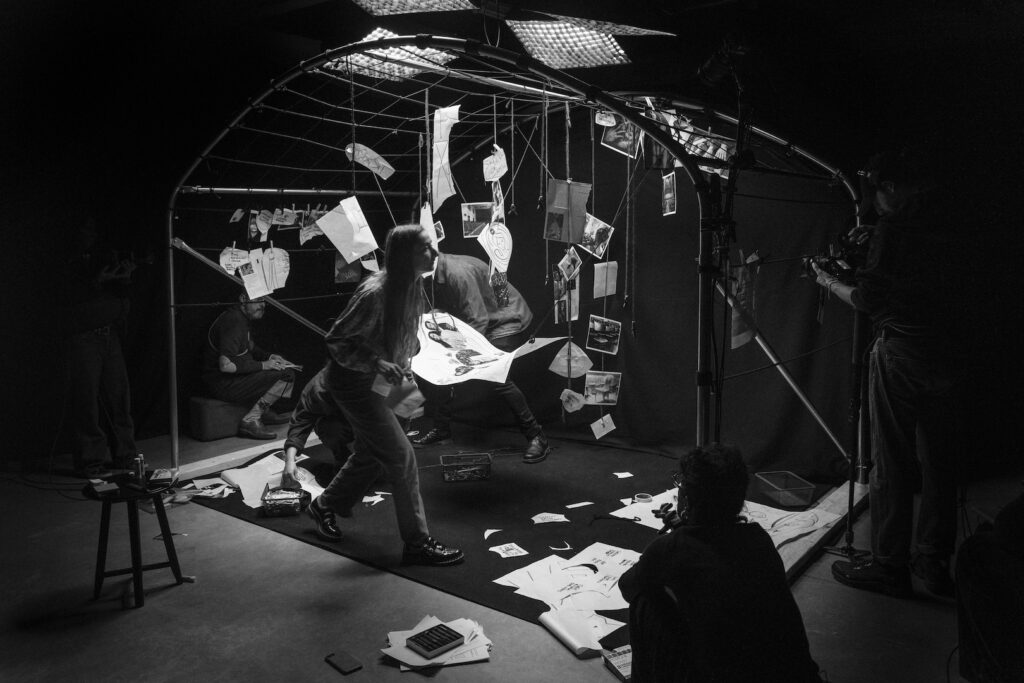
UNFOLDING THE NARRATIVE IN SPACE
“The Cave allowed us all to have autonomy in co-creating the story”
I go into the Cave with two other writers, and none of the three of us really knows how we’re going to collaborate. There’s no designated leader; there’s enough space for all of us. Each of us plays our part, experimenting with what would happen if we put this here, if we looked over there, and one of us suggests something that connects the dots. The Cave allows us autonomy in co-creating the story: which makes the experience rare because it’s unique. In the Cave, we try, together, to envision a truly shared idea, and having a three-dimensional space helps us do that. – Isla Badenoch
STORYTELLING: A MANUAL WORK
“The Cave is like a kind of corridor, a physical space that encourages ideas to advance”
I see the Cave as a place where you can deconstruct everything, lay everything down, and then the process of creating the story begins, through the movement around it. The Cave is like a kind of corridor, a physical space that encourages ideas to advance. When you’re in front of a screen, you only face what you have, at that precise moment. It’s then very fixed, as if we were screenwriters ourselves, rigid, often with a block: “writer’s block.” The Cave allows for a truly creative dynamic, bringing old and new ideas together to extract their essence and, from there, build the story. The analog elements nourish it. Everything contributes to constructing a piece of history that is totally connected and relevant to the story. Writing should probably be a manual job and that is what the Cave allows. – Gabrielle Brady
THE SINGLE ACT OF CREATING THE STORY
“What happened in the Cave will never happen again”
What happens in the Cave will never happen again. It is in no way reproducible, with the same ideas, the same people. Even if you brought everyone together in a week, the people would be different, the ideas would be different, everything would be different. The interesting thing about creativity research is that every creative act is necessarily individual. There is no such thing as a repeated creative act. – Wendy Ross
THE COMPOSITION OF THE STORY, THROUGH COOPERATION
“I’m fascinated by the efficiency of the human machine: all these people who don’t know each other and who cooperate.”
I’m fascinated by the efficiency of the human machine, all these people who don’t know each other and who cooperate, even though it’s difficult. – Yves Sarfati
There’s something very pleasant about these groups that form very quickly and intensely. It’s wonderful to trust people you don’t really know, I love it! – Wendy Ross
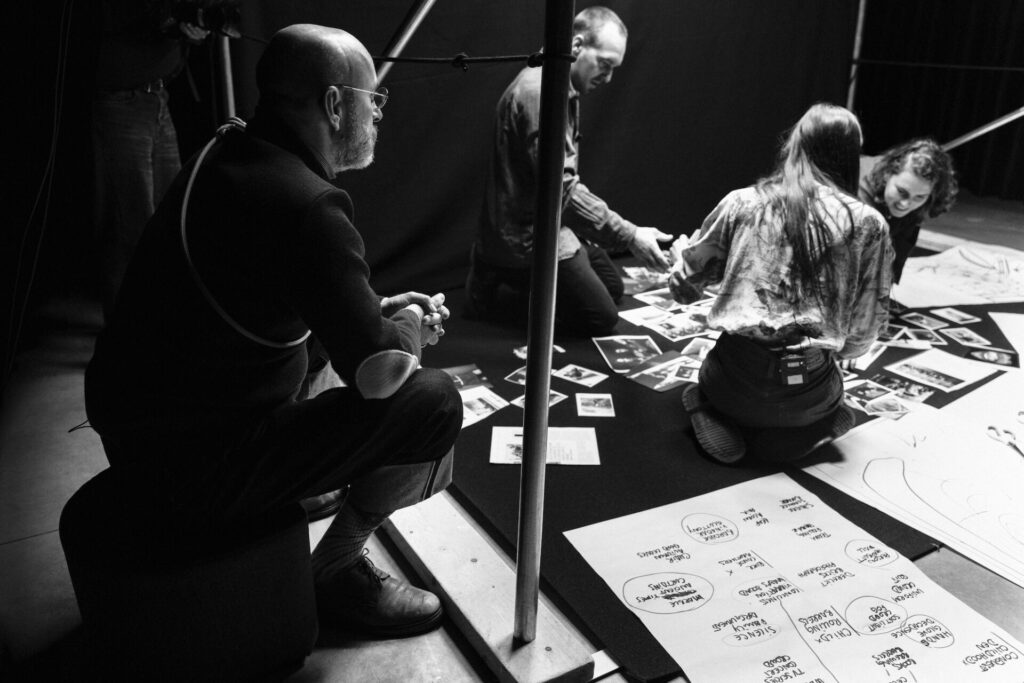
COMPOSING THE NARRATIVE: WALKING THROUGH HISTORY
“All these images are in no way an end in themselves, but a means of transportation.”
In the Cave, combining image research using artificial intelligence with iconographic material that you have to create, through magazines, through clipping, etc., opens up new possibilities, allowing you to immediately enter the universe visually, while at the same time not getting stuck there. It’s a rare sensation, a unique atmosphere.
It’s not, in fact, the visual that we’re looking for, it’s not where we’re going. All these images are in no way an end in themselves, but a means of transportation. – Samira Bourgeois-Bougrine
There’s really the idea of a path, a logic of progression that’s more important than the final result, with a practice close to improvisation. With the power of conversation at the heart of what we are doing, the very basis of collaboration in the composition of the story. – Théo Gorin

TELLING THE STORY: TAKING IT, CUTTING IT UP, PUTTING IT TOGETHER
“With the Cave, we stop thinking that the idea is only cerebral; the idea is also outside of ourselves: it’s there.”
In the Cave, there’s something playful about the act of doing that’s extremely enjoyable: taking it, cutting it up, displaying it. The whole body is then engaged. We stop thinking that the idea is only cerebral; the idea is also outside of ourselves: it’s there. – Théo Gorin
When one of the groups drew swirling wasps on a piece of paper, in the center, which they hung early on to populate the ceiling of the Cave, the wasps suspended by strings with pincers became central and blocked their path, hindering them. The idea is to know how this action followed by another could influence the following ideas of the ongoing story. – Samira Bourgeois-Bougrine
GRUBER’S THEORY ON CONSTRUCTIVE REPETITION
“The fluctuations, the amplifications of the deviations emerge”
Within the Cave, the idea that Howard E. Gruber and several other creativity researchers have explored can be deployed: constructive repetition. If you do something again and again, very quickly—and I always think of Van Gogh, who painted Sunflowers very quickly—you don’t have time to correct yourself. Thus, the fluctuations, the amplifications, the deviations emerge. By moving very quickly from one thing to another, again and again, you explore, even more, the narrative in composition. Michael Hanchett Hanson
MOVING THROUGH THE STORY TO THINK ABOUT IT DIFFERENTLY
“Occupying the Cave with your body”
The Cave is a three-dimensional space, a greenhouse! The whole point is to be able to occupy a space with your body, to struggle to hang something, especially, and not only. All of this makes for a totally interesting experience because it forces you to move through the space and think differently. Jean-Loïc Le Quellec
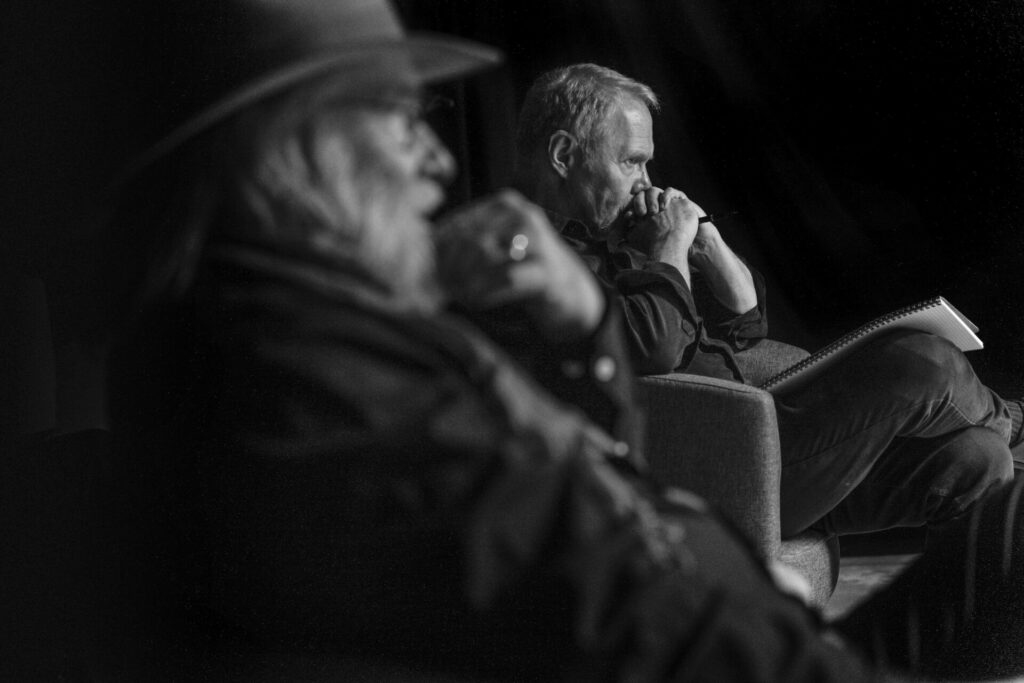
ARCHITECTING THE STORY
“In the Cave, we define the boundaries of the story”
In the Cave, we define the boundaries of the initiated story. Because once we’ve created the seed of the story upfront, the possibilities are endless. Within the Cave, we try to establish the framework: where are the walls, the floor… And we lock everything down, we collectively define the limits for our wandering minds. In reality, it’s not about “populating” the Cave with ever more material, but about doing it with these initial materials. We established the boundaries where the three of us would be, as co-authors. Raitis Ābele

